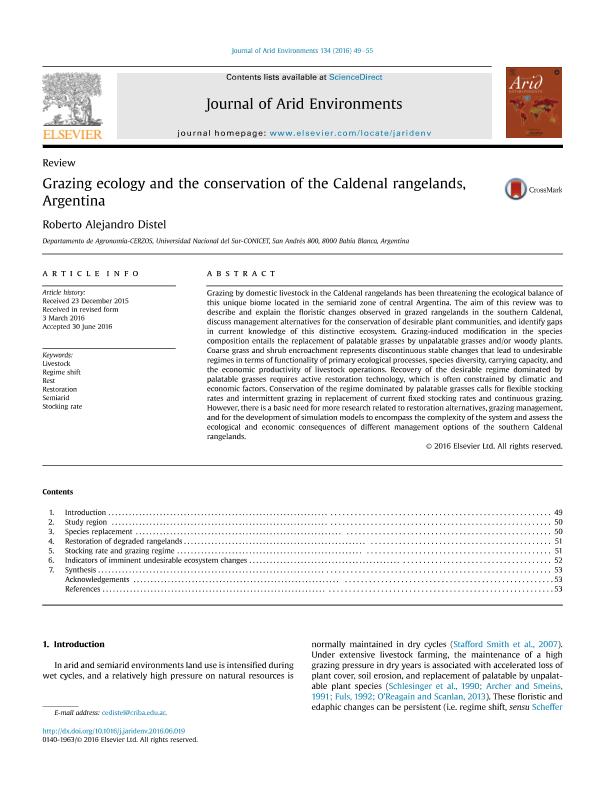Mostrar el registro sencillo del ítem
dc.contributor.author
Distel, Roberto Alejandro

dc.date.available
2017-07-03T19:54:44Z
dc.date.issued
2016-11
dc.identifier.citation
Distel, Roberto Alejandro; Grazing ecology and the conservation of the Caldenal rangelands, Argentina; Elsevier; Journal of Arid Environments; 134; 11-2016; 49-55
dc.identifier.issn
0140-1963
dc.identifier.uri
http://hdl.handle.net/11336/19414
dc.description.abstract
Grazing by domestic livestock in the Caldenal rangelands has been threatening the ecological balance of this unique biome located in the semiarid zone of central Argentina. The aim of this review was to describe and explain the floristic changes observed in grazed rangelands in the southern Caldenal, discuss management alternatives for the conservation of desirable plant communities, and identify gaps in current knowledge of this distinctive ecosystem. Grazing-induced modification in the species composition entails the replacement of palatable grasses by unpalatable grasses and/or woody plants. Coarse grass and shrub encroachment represents discontinuous stable changes that lead to undesirable regimes in terms of functionality of primary ecological processes, species diversity, carrying capacity, and the economic productivity of livestock operations. Recovery of the desirable regime dominated by palatable grasses requires active restoration technology, which is often constrained by climatic and economic factors. Conservation of the regime dominated by palatable grasses calls for flexible stocking rates and intermittent grazing in replacement of current fixed stocking rates and continuous grazing. However, there is a basic need for more research related to restoration alternatives, grazing management, and for the development of simulation models to encompass the complexity of the system and assess the ecological and economic consequences of different management options of the southern Caldenal rangelands.
dc.format
application/pdf
dc.language.iso
eng
dc.publisher
Elsevier

dc.rights
info:eu-repo/semantics/openAccess
dc.rights.uri
https://creativecommons.org/licenses/by-nc-nd/2.5/ar/
dc.subject
Livestock
dc.subject
Regime Shift
dc.subject
Rest
dc.subject
Restoration
dc.subject
Semiarid
dc.subject
Stocking Rate
dc.subject.classification
Ecología

dc.subject.classification
Ciencias Biológicas

dc.subject.classification
CIENCIAS NATURALES Y EXACTAS

dc.title
Grazing ecology and the conservation of the Caldenal rangelands, Argentina
dc.type
info:eu-repo/semantics/article
dc.type
info:ar-repo/semantics/artículo
dc.type
info:eu-repo/semantics/publishedVersion
dc.date.updated
2017-07-03T14:52:02Z
dc.journal.volume
134
dc.journal.pagination
49-55
dc.journal.pais
Países Bajos

dc.journal.ciudad
Amsterdam
dc.description.fil
Fil: Distel, Roberto Alejandro. Consejo Nacional de Investigaciones Científicas y Técnicas. Centro Científico Tecnológico Conicet - Bahía Blanca. Centro de Recursos Naturales Renovables de la Zona Semiarida. Universidad Nacional del Sur. Centro de Recursos Naturales Renovables de la Zona Semiarida; Argentina
dc.journal.title
Journal of Arid Environments

dc.relation.alternativeid
info:eu-repo/semantics/altIdentifier/url/http://www.sciencedirect.com/science/article/pii/S0140196316301203
dc.relation.alternativeid
info:eu-repo/semantics/altIdentifier/doi/http://dx.doi.org/10.1016/j.jaridenv.2016.06.019
Archivos asociados
